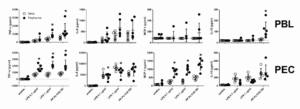Trauma Causes an Immunosuppressive Response to Secondary Microbial Challenge
Author(s):
Anja Fuchs; Sarbani Ghosh; shin-wen Chang; Grant Bochicchio; Isaiah Turnbull
Background:
Background: Traumatic injury is associated with a 3-fold increase in the rate of ventilatory associated pneumonia (VAP) resulting in 40% of trauma patients requiring intubation developing VAP. To determine how injure effects the systemic response to infection, we measured the inflammatory response secondary LPS challenge in a clinically relevant murine model of injury induced immune dysfunction.
Hypothesis:
We hypothesized that injury would suppress the inflammatory response to secondary microbial challenge.
Methods:
C57BL/6 mice were subjected to polytrauma comprised of a 30% blood volume hemorrhage, bilateral lower extremity pseudofracture and a liver crush injury, a modification of our previously described protocol. 2 cohorts of mice were studied 48 hours after injury. In cohort 1, animals were challenged 1 mg/kg LPS and plasma cytokines were measured 6 hours after LPS. In cohort 2, peripheral blood leukocytes (PBL) and peritoneal exudate cells (PEC) were isolated, stimulated with LPS or heat-killed Pseudomonas Aeruginosa (HKPA) and inflammatory cytokine production measured ex-vivo. Cytokines were assayed by cytometric bead array (BD) and compared by t-test.
Results:
In injured animals, LPS challenge resulted in elevated levels of IL-10 (79+/- 51 pg/ml vs. 30+/-13 pg/ml, p<0.05) and a significantly decremented Interferon-gamma response (27+/-14 pg/ml vs. 90+/-24 pg/ml, p<0.05). Ex-vivo stimulation of PBL with LPS or HKPA demonstrated that cells from injured mice produced significantly higher levels of TNF-alpha and IL-10 as compared to uninjured controls. PEC from injured mice produced higher levels of TNF-alpha, MCP-1 but produced lower levels of IL-10 as compared to controls.


